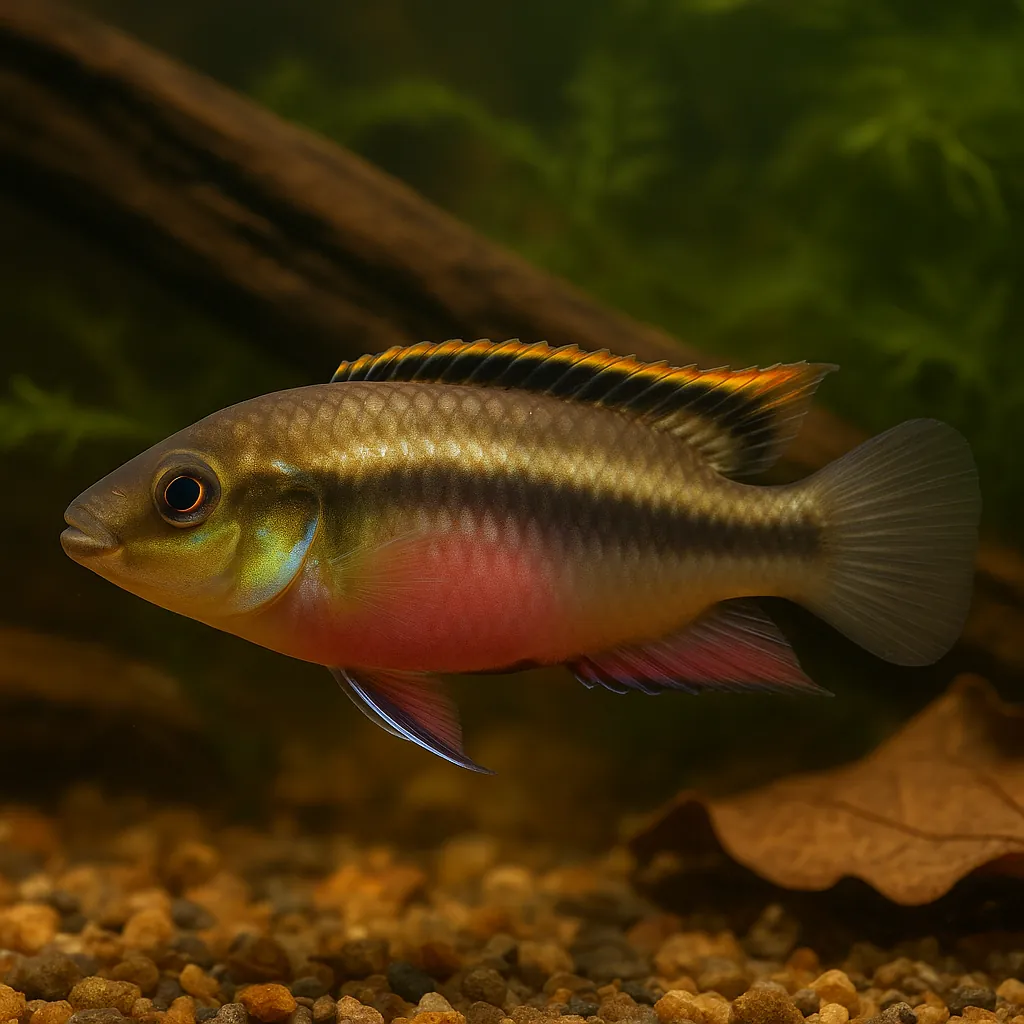
Kribensis
Introduction
The Kribensis cichlid (Pelvicachromis pulcher), often simply called "Kribs," is a vibrant and popular choice among aquarists. Renowned for their striking coloration and manageable size, these fish are well-suited for both beginner and intermediate fishkeepers. Their relatively peaceful nature and fascinating breeding behaviors add to their appeal, making them a delightful addition to freshwater aquariums.
What makes Kribensis cichlids a popular choice for aquarists?
Kribensis cichlids are favored for their vivid colors, ease of care, and engaging behaviors, especially during breeding.
Are Kribensis suitable for beginners?
Yes, their hardy nature and adaptability make them an excellent choice for novice fishkeepers.
Care and Environment
Providing optimal care for Kribensis cichlids involves replicating their natural habitat and meeting their specific needs.
What is the minimum tank size for a pair of Kribensis?
A minimum of 50 liters is recommended for a single pair, though larger tanks are preferable to accommodate their territorial behavior.
What are the ideal water parameters for Kribensis?
Maintain a temperature between 24°C and 27°C, a pH of 6.0 to 7.5, and soft to moderately hard water.
Effective filtration is crucial to keep the water clean, but ensure the flow is gentle, as Kribensis prefer calm waters. Moderate lighting is sufficient, and incorporating live plants like Anubias, Java Fern, and Cryptocoryne provides cover and mimics their natural environment.
Use a fine sand or small-grain gravel substrate to accommodate their occasional digging behavior. Including caves or hiding spots, such as clay pots or driftwood, is essential, especially during breeding periods when they become more territorial.
Feed Kribensis a varied diet consisting of high-quality flake or pellet food, supplemented with live or frozen foods like brine shrimp, bloodworms, and daphnia. Occasional vegetable matter, such as blanched spinach or peas, can also be offered.
Regular maintenance, including weekly water changes of 20-30%, helps maintain water quality and the health of your fish.
How can I reduce aggression in Kribensis during breeding?
Providing ample hiding spots and ensuring sufficient space can help minimize territorial disputes during breeding periods.
Origin and Habitat
Kribensis cichlids are native to the freshwater rivers and streams of Nigeria and Cameroon in West Africa. They inhabit areas with dense vegetation and slow-moving waters, often found in shallow regions with sandy or muddy substrates.
What type of environment do Kribensis naturally inhabit?
They thrive in slow-moving, densely vegetated freshwater rivers and streams with sandy or muddy bottoms.
How does their natural habitat influence their care in aquariums?
Replicating their natural environment with plants, hiding spots, and appropriate substrate helps them feel secure and exhibit natural behaviors.
Temperament and Compatibility
Kribensis are generally peaceful but can become territorial, especially during breeding. They coexist well with other peaceful species such as tetras, rasboras, and Corydoras catfish.
Can Kribensis be kept with other cichlids?
They can be housed with other non-aggressive dwarf cichlids, provided there is enough space to establish territories.
What tank mates should be avoided?
Avoid housing them with overly aggressive fish or fin-nippers, as this can lead to stress and conflict.
Providing ample space and hiding spots can help reduce territorial disputes and promote a harmonious tank environment.
Interesting Facts
Kribensis cichlids are known for their unique breeding behaviors. During courtship, females display a vibrant purple belly to attract males. Once paired, they often choose caves or similar structures for spawning, with both parents actively guarding and caring for the fry.
How do Kribensis parents care for their young?
Both parents are involved in guarding the eggs and fry, often leading them around the tank and protecting them from potential threats.
Are Kribensis prone to digging?
Yes, they exhibit digging behavior, especially during breeding, which is why a soft substrate is recommended.
Sources
All information in this article has been gathered from the following reputable sources:
Overview
Recommended Tank Size 33 Gallons (for a pair in a community tank) |
Minimum Group Size 2 |
Maximum Adult Size |
Minimum Tank Volume 13.2 Gallons |
Maximum Adult Length 3.9 inches |
Average Adult Length 3 inches |
Shoaling (6+ required) No |
Preferred Water Type Freshwater, soft to moderately hard, slightly acidic to neutral |
Temperature Range (°C) 24–27 |
pH Range 6.0–7.5 |
Water Hardness (dGH) 5–12 |
Typical Lifespan (years) 5 years |